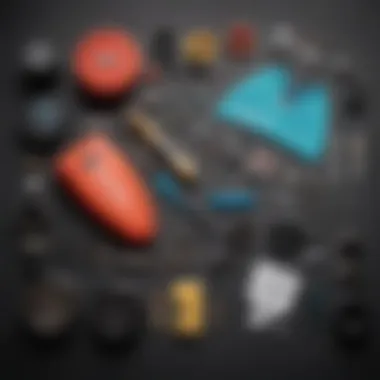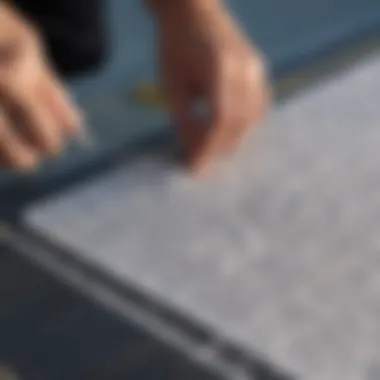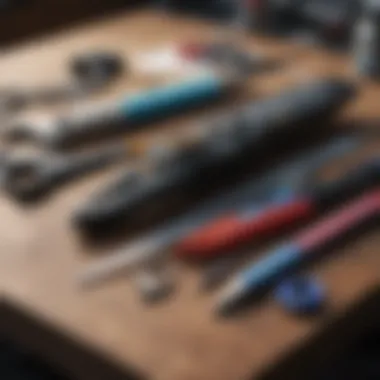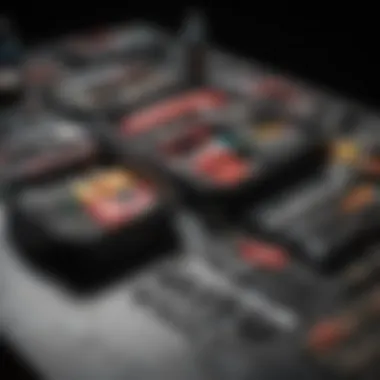Kite Repair Kit: Key to Kitesurfing Survival


Intro
When engaging in kitesurfing and kiteboarding, the potential for equipment damage is a reality that every enthusiast faces. From minor rips and tears to severe impacts that could render a kite unusable, knowing how to address these issues is crucial. This is where a kite repair kit becomes an indispensable asset. Not only does it serve to extend the life of your gear, it also allows riders to respond quickly to unexpected mishaps.
In this article, we will explore the key components of an effective kite repair kit, detailing the essential items to include and providing insights into various repair techniques. By understanding the significance of these tools and techniques, both novice and experienced riders can prioritize equipment maintenance, ultimately improving safety and prolonging the enjoyment of their kitesurfing adventures.
Equipment Reviews
Having a well-equipped kite repair kit is just one aspect of ensuring a great experience on the water. Understanding the equipment you are using is equally vital to enhance performance and safety. Therefore, it's essential to delve into the equipment reviews for kites, boards, and other accessories.
Kites
In the world of kitesurfing, kites are the primary tool used for harnessing wind power. Here, we will discuss the latest models available, examining their features and performance.
- Kite Shapes: Understanding how different shapes affect performance is essential. C-shaped kites, for instance, offer enhanced stability and power, while delta-shaped kites provide better lift and are easier to handle in diverse wind conditions.
- Sizes: Kite sizing is a crucial element. Larger kites can generate more power in light winds, whereas smaller kites are preferable in stronger wind conditions to prevent overbearing pull.
- Materials: The construction of kites typically involves durable materials like ripstop nylon or polyester, which provide resilience against wear and tear.
- Brands: Leading brands such as Naish, Cabrinha, and Slingshot offer a range of kites tailored to different riding styles and skill levels.
Boards
The choice of a kiteboarding board is equally important in achieving optimal performance. In this section, we will review the various types of boards available, focusing on design, construction, and how each board suits different riding styles.
- Twintips: These boards are versatile and are commonly used for freestyle riding. Their symmetrical design allows for easy switching between riding directions.
- Directional Boards: These are designed for wave riding and often offer better control and upwind capabilities.
Accessories
Accessories play a pivotal role in enhancing the kitesurfing experience. It is vital to understand their importance. This section will cover the essential accessories needed for safe and effective riding.
- Harnesses: Essential for connecting the rider to the kite, they come in various styles such as seat harnesses and waist harnesses, each suited for different riding preferences.
- Lines: Quality lines ensure reliable connection and control. Inspecting and replacing worn-out lines can significantly impact safety.
- Pumps: A good pump is necessary for efficiently inflating your kite. A double-action pump can save time and effort.
- Safety Gear: Helmets and impact vests are recommended for added protection, especially in challenging conditions.
A well-equipped kite repair kit enhances safety and allows for quick repairs, preserving the integrity of your equipment.
Preparation and knowledge go hand in hand in ensuring a successful kitesurfing experience. By understanding and selecting the correct equipment — including kites, boards, and accessories — you open up a world of possibilities on the water.
Understanding the Importance of a Kite Repair Kit
Kite repair kits serve a crucial role in kitesurfing and kiteboarding activities by ensuring that enthusiasts can respond to unexpected damages efficiently. Understanding their importance goes beyond mere convenience; it is fundamental to safety and extending the life of expensive gear.
Enhancing Safety During Kitesurfing
Safety is paramount in kitesurfing. Functional kites are necessary to control the equipment properly and prevent accidents. A kite repair kit can be invaluable when a kite sustains damage during use. Having quick access to a repair kit allows riders to patch up minor tears or seal small leaks, enabling them to safely return to shore or finish their session. This quick thinking can prevent severe incidents that may arise from a malfunctioning kite.
"A well-stocked repair kit can be the difference between a fun day and a dangerous situation on the water."
In particular, various components within the repair kit, such as self-adhesive patches and seam tape, are specifically designed to be durable under pressure. This durability ensures that even a temporary fix can be trusted to last until a more thorough repair can be executed. Proper safety measures during kitesurfing cannot be ignored, and having a kite repair kit on hand is an essential part of any rider's preparedness.
Extending the Lifespan of Your Kite
Kites are not inexpensive investments, and the longevity of these items depends significantly on how well they are maintained. A kite repair kit can facilitate timely repairs, which consequently helps avoid costly replacements. Small tears and damages can lead to larger problems if not addressed promptly.
By regularly using a repair kit to care for kites, enthusiasts can improve the overall lifespan of their equipment. For example, applying fabric patches immediately upon noticing minor fabric damages can prevent further deterioration. Regular use and maintenance with the right tools can sustain a kite's functionality for several additional seasons.


In summary, neglecting repairs can shorten the life of the kite significantly. Thus, having the essential repair tools readily available ensures that any damage is addressed swiftly, preserving the kite's performance and safety during use.
Components of an Effective Kite Repair Kit
The importance of having a kite repair kit lies in its role as a safety net for kitesurfers and kiteboarders. Equipment used in these sports is often subject to wear and tear. By being prepared with the right tools and materials, one can prevent small issues from escalating into major problems. A well-stocked repair kit gives kitesurfers confidence while out on the water, knowing that they have the means to address any unexpected situation. Just as one would never go hiking without a first aid kit, one should never venture into kitesurfing without their kite repair kit.
Essential Repair Materials
Fabric Patches
Fabric patches are a critical part of any kite repair kit. They serve to cover tears or holes in the kite material, providing a quick solution that restores structural integrity. Patches are usually made from materials similar to what the kite is constructed from, which helps maintain performance. They are popular among kitesurfers due to their effectiveness and ease of application. The key characteristic of fabric patches is their adhesive backing, making it simple to position and stick them onto the damaged area. However, one must ensure that the kite is clean and dry before applying, as dirt can compromise adhesion.
Adhesives
Adhesives play a pivotal role in kite repair kits. They are essential for bonding fabric patches securely. Many kitesurfers choose specific types of adhesives designed for use with kite materials. These adhesives have a fast-setting time, which allows for efficient repairs. Their strong bonding capabilities can withstand the conditions faced during kitesurfing, making them a reliable choice. However, some users find it challenging to manage the application without creating a mess, which is something to be aware of.
Seam Tape
Seam tape is another vital component. It works by reinforcing the seams of the kite, which are common points of failure. The primary benefit of seam tape is its ability to create a waterproof seal, preventing leaks and protecting against further damage from water inflow. Its application is straightforward, and it can add extra durability to kites that have faced wear. On the downside, one should keep in mind that seam tape can sometimes peel away over time if not applied properly.
Tools for Quick Fixes
Scissors
Scissors are an often-overlooked tool in kite repair kits. They are essential for trimming frayed edges and cutting patches to size. A quality pair of scissors designed for heavy fabric will make a significant difference in the speed and cleanliness of repairs. Many kitesurfers appreciate the convenience of having them readily available. However, not all scissors are created equal. Some may struggle with thicker fabrics, which is a limitation to consider.
Measuring Tape
Measuring tape is critical for ensuring that patches and repairs fit correctly. Accurately measuring the damaged area will influence the effectiveness of the repair. A retractable measuring tape offers convenience and ensures precision. Notably, one must be diligent in measuring since an incorrect size can result in wasted materials or ineffective repairs. Failing to measure properly can lessen the repair's effectiveness, which can lead to further complications.
Patch Iron
A patch iron is instrumental when applying fabric patches. It provides the heat necessary to activate the adhesive backing, ensuring a strong bond. This tool is user-friendly, especially for those with limited experience in repairs. However, caution is necessary, as applying too much heat can damage the kite material. It is worthwhile to practice on scrap fabric to hone one’s skills before making repairs on an actual kite.
Common Kite Issues and Repairs
Kite enthusiasts know that kites are just as susceptible to damage as any other piece of equipment. Understanding common kite issues and the repairs needed is essential for maintaining both performance and safety in kitesurfing and kiteboarding. This knowledge can significantly enhance a user’s experience on the water.
Regular maintenance ensures longevity and reliability, while quick fixes help to prevent minor issues from escalating into more significant problems. As kites are exposed to various environmental conditions like wind, water, and sharp objects, homeowners need to be equipped with both knowledge and repair kits to deal with any eventualities.
Dealing with Fabric Tears
Fabric tears can occur unexpectedly during kitesurf sessions, often caused by sharp objects or edges. The importance of addressing these tears cannot be overstated. If ignored, even a small tear can compromise the kite's structural integrity, leading to potential equipment failure. Quick identification and repair can prevent these situations.
Steps to Repair Fabric Tears:
- Identify the tear’s location and size.
- Clean the area around the tear to ensure proper adhesion.
- Apply a fabric patch, using adhesive or tape, according to the material's requirements.
- Press down firmly and let it cure as per the adhesive instructions.
Using a strong adhesive will help stabilize the patch and extend the kite’s life. Carrying a few extra fabric patches in your repair kit can assist in managing these types of repairs effectively.
Repairing Leaks in Inflatable Kites


Inflatable kites are popular for their stability and ease of use. However, they are not immune to leaks, which can be frustrating and sometimes dangerous. A leak may occur due to worn seams or punctures. Identifying and repairing these issues promptly is critical.
Repair Process for Leaks:
- Locate the source of the leak by submerging the kite in water and looking for bubbling.
- Dry the affected area and prepare it for a patch.
- Use a leak repair adhesive specifically designed for inflatable materials.
- Apply the adhesive, ensuring it is evenly distributed.
A repair kit specifically designed for inflatable kites can often include patches and adhesives that are best suited for these quick fixes. Keeping the kit sealed and dry will also help maintain the repair materials.
Fixing Broken Lines and Connections
Broken lines and connections can lead to serious consequences in kitesurfing. Other than being a nuisance, they can severely compromise a rider’s control and safety. As lines wear out over time, regular inspections become essential to catch wear and material failure before they become an unmanageable issue.
How to Repair Broken Lines:
- Inspect all lines for fraying or breaks regularly.
- To repair, remove the damaged section and splice or knot the line securely.
- Make sure that connections to the kite's harness are also secure and functional.
Keeping spare lines, a splicing kit, and some extra connectors in your repair kit can be very useful for quick fixes when needed.
Remember, having a well-equipped kite repair kit enables you to address common issues effectively and enhances your overall kitesurfing experience.
By knowing common challenges and how to tackle them, you set yourself up for safer and more enjoyable sessions on the water.
Preventive Measures to Avoid Kite Damage
Preventive measures are critical when it comes to kitesurfing. Understanding how to handle your kite properly can save you from costly repairs and ensure your time on the water is enjoyable and safe. Taking proactive steps to protect your gear can prolong its life significantly. Here, we will discuss the two main components: proper use and handling of kites, and safe storage solutions.
Proper Use and Handling of Kites
When engaging with kites, the way you use and handle them plays a substantial role in their longevity. It is essential to be aware of environmental conditions. Wind speed can change quickly, impacting your kite's performance. Using your kite in excessively high winds can lead to structural damage. Additionally, attentiveness during launches and landings is crucial. Carelessness can lead to tears or improper inflation. Recognizing the limits of your kite’s size and design enhances not only safety but also durability.
To properly use your kite, follow these guidelines:
- Check Equipment Before Use: Regularly inspect for wear and tear, especially the lines and fabric.
- Launch in an Open Area: Make sure there is enough space to avoid potential obstacles.
- Avoid Abrasive Surfaces: Keep the kite away from sharp objects and rough terrains.
- Practice Control: Proper steering and stopping techniques help prevent excessive wear.
By adhering to these points, you can avoid many common issues that arise from improper handling. Making a habit of this attention can safeguard your equipment from damage.
Safe Storage Solutions
The ability to store your kite correctly can be a deciding factor in how often you need to make repairs. Storing your kite in a cool, dry, and shaded area reduces the risk of UV and moisture damage. It is advisable not to keep a folded kite in a bag for long periods, as creases and pressure can weaken the fabric over time.
Here are some best practices for safe storage:
- Use a Dedicated Bag: Store kites in specially designed storage bags that provide protection from elements.
- Avoid Overloading: Do not stack heavy items on top of the kite bag. This can create undue pressure and lead to damage.
- Regular Checks: Routinely remove the kite from storage to inspect for any potential issues such as mold or deterioration.
The Role of Routine Maintenance
Routine maintenance is a cornerstone of optimal kite performance and longevity. Without it, even the highest quality kites can suffer from wear and tear that may compromise safety and enjoyment. Understanding the role of routine maintenance involves recognizing key practices that can avert significant issues and improve the overall lifespan of kitesurfing gear.
Routine maintenance fosters a proactive approach. By regularly inspecting equipment, users can address minor complications before they escalate into major problems. This diligence not only enhances safety while kitesurfing but also diminishes the frequency and extent of repairs needed. Moreover, well-maintained equipment can perform better, resulting in superior kitesurfing experiences. Regular checks encourage a comprehensive understanding of the kite’s condition and help in identifying parts that may need early intervention or replacement.


Regular Inspections
Regular inspections are fundamental to maintaining kites. Every session should begin with a thorough examination of the gear. Check for any visible signs of damage, such as frayed lines, chipped leading edges, or wear on the bladders. Pay particular attention to:
- Lines and connections: Look for fraying, knots, or misalignments that can affect performance.
- Fabric integrity: Examine the material for any rips or tears that require immediate attention.
- Inflation system: Ensure that all valves are functioning correctly and not leaking air.
Conducting these inspections can prevent unexpected failures during use. If any issues are detected, they should be addressed before hitting the water. Keeping a maintenance log that outlines inspections and any repairs can also help track the kite’s health over time.
Tuning Equipment Post-Use
Tuning equipment after each session is as vital as pre-usage inspections. This process includes adjusting lines to the correct tension and ensuring that the kite is packed properly to avoid damage during transport. Consider the following:
- Line Lengths: Ensure that the front and back lines are of equal length to maintain kite balance.
- Trimming Settings: Adjust the trim line according to the wind conditions encountered during the session. Correct trimming enhances control and response.
- Storage: Store the kite in a cool, dry place. Utilize protective bags to prevent abrasions and punctures.
The juxtaposition of thorough inspections and diligent post-use tuning creates a comprehensive maintenance routine. This approach ensures that every kitesurfing adventure is safe, enjoyable, and devoid of unforeseen complications, allowing for a seamless connection between the athlete and the environment.
In summary, establishing a habit of routine maintenance, regular inspections, and post-use tuning safeguards your investment and elevates your kitesurfing experience.
Storage and Transportation of the Kite Repair Kit
Proper storage and transportation of a kite repair kit plays a critical role in ensuring that kitesurfers are always prepared for unexpected issues. It is not enough to simply have a repair kit; how and where it is kept can significantly affect its accessibility and functionality when needed. Storage solutions should focus on organized compartments that prevent items from shifting while moving, as well as offering protection from environmental elements like moisture and sand.
When traveling to kitesurfing locations, a structured approach to transportation not only secures the kit's components but also makes retrieval easier in case of an urgent repair. Consideration should also be given to the weight and size of the container, as hefty or bulky solutions can be cumbersome to carry. An easily portable kit can make the difference when an urgent repair is required just before hitting the waves.
Choosing the Right Container
Selecting an apt container for the kite repair kit is crucial. The right one should be durable, waterproof, and lightweight. Kitesurfers often face a variety of conditions, so the container must withstand exposure to saltwater and sand. Several factors can be considered:
- Size: Ensure it is large enough to house all essential items but compact enough for easy transportation.
- Material: Material choices should include reinforced fabrics or hard-shell cases to prevent damage.
- Compartments: Look for options with multiple compartments to organize different tools and materials, making aid for repairs straightforward.
A sturdy duffel bag or a specialized kite repair box can serve well. Some kitesurfers prefer using hard-shell boxes with foam padding to protect their gear during transportation. It is advisable to choose a container that can be easily attached to other gear or stowed in a vehicle.
Keeping Repairs Accessible on the Go
Kitesurfing often involves spontaneity. Therefore, keeping repairs accessible while on the go is of utmost importance. A well-organized kit minimizes downtime on the beach and allows quick fixes that can keep you out on the water longer.
Consider the following tips:
- Accessibility: Place frequently used materials, such as adhesive patches, on top or in easily reachable compartments.
- Clear Labeling: Use labels or color-coded bags to identify different repair components swiftly.
- Portable Tools: Include lightweight tools, such as a small scissors or a patch iron, that can be used without hassle.
For traveling kitesurfers, having a smaller, secondary repair kit could also be useful. This kit can be lighter and just have essential tools for minor repairs, making it easy to grab while out on the water.
Having the right storage and transportation plan can make the difference between enjoying a day of kitesurfing and dealing with an avoidable setback.
Epilogue: Preparing for the Unexpected in Kitesurfing
Kitesurfing can be an exhilarating and rewarding sport, but it is not without its challenges. A kite repair kit is essential for dealing with potential issues that can arise while on the water. When unexpected situations occur, having the right tools and materials at hand can make a significant difference.
An effective kite repair kit can ensure your safety and enhance your enjoyment of the sport. If your kite sustains damage, not having a repair kit could leave you stranded or, worse, lead to dangerous situations. Therefore, its importance cannot be overstated. With a well-stocked repair kit, you can address problems efficiently, allowing you to return to kitesurfing without unnecessary delay.
Considerations when preparing for kitesurfing include the types of repairs you might need to make. You should be familiar with the common issues that can happen, such as tears in the fabric or issues with the connection lines. Each component of your kit serves a purpose, whether it is fabric patches, adhesives, or tools. All of these can help you quickly assess and fix the damage.
Preparing for the unexpected means that you will not only enhance your experience but also prolong the lifespan of your gear. Regular maintenance checks and having a robust repair kit ensure that any problems can be quickly resolved. This proactive approach can ultimately save you money and time in the long run.
"Invest in your kite repair kit today, and it will pay dividends in your kitesurfing experience tomorrow."
Whether you are a novice or an experienced kitesurfing enthusiast, your preparation can substantially impact your sessions. Only through thoughtful planning and proper equipment can you truly embrace the thrill of kitesurfing.







